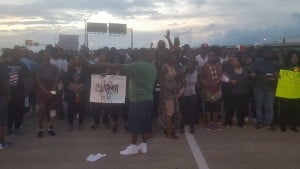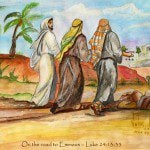Tokenism is pervasive in American dialogue. Consider activist DeRay McKesson’s appearance on Fox News’ “Hannity.” DeRay was interviewed to discuss his role as an activist, while Hannity’s black guest Kevin Jackson chided DeRay calling him a “race pimp and race hustler.” The meritocratic myth is pervasive in America and it functions to validate the status of one’s place on the social ladder: if you’re poor, it’s your own fault; if you’re rich, you’ve taken advantage of the “opportunities” in America. However, tokenism doesn’t only serve to promote the narratives of the state, it also serves to scapegoat the leader of given society who is responsible for “keeping the peace” in a given community.
In his historical work on the Greco-Roman world, New Testament historian James Jeffers provides us with similar dynamics regarding the social situation of Jesus’ time. King Herod, the “half-Jew”, was also granted political authority to rule over Judea, as a client-king, or representative of an area at risk of rebellion. In The Greco-Roman World of the New Testament Era, Jeffers writes:
The governors of Judea came from a group of imperial administrators, named procurators or prefects used to govern relatively small areas, that required special treatment. For the most part this meant quasimilitary governing of newly acquired areas, or of peoples considered potentially rebellious. Mauritania, the island of Sardinia, Egypt, and several districts in the Alps were governed by procurators. Procurators were taken from the order just below the senatorial, the equestrian. Before A.D. 44 these governors, like Pontius Pilate, were called prefects… A number of territories, especially in the eastern part of the Empire, were governed by client kings [Herod]. These were native [emphasis mine] dynasties approved by Rome, who ruled with one eye on their people and the other on Rome…” (113-14)
Sadly, some of the fiercest purveyors and custodians of white supremacy, racism, meritocracy, and respectability are black and brown folks; and some of the fiercest purveyors and custodians of patriarchy, sexism, and purity/shame culture are women. As their allegiance remains with empire, their politics remain oppressive. This was sister, Jill Stein’s case against the feminism of Hillary. And the oppressive policy and rhetoric causes the little ones to demand justice, and sometimes in the most extreme and harmful ways. In his letter from Birmingham jail, Martin Luther King describes this phenomenon of resistance to the clergymen:
There comes a time when the cup of endurance runs over, and men are no longer willing to be plunged into the abyss of despair.”
Jesus says of them: “If anyone causes one of these little ones—those who believe in me—to stumble, it would be better for them to have a large millstone hung around their neck and to be drowned in the depths of the sea. Woe to the world because of the things that cause people to stumble! Such things must come, but woe to the person through whom they come! -Matthew 18.6-7
Who are the little ones in America if not those who are economically and racially segregated, occupied, and killed on a 25-hour schedule? And who are the ones who cause them to stumble if not the purveyors of the status quo and those who physically and verbally harm them?
Jesus’ birth among animals, his upbringing in Nazareth, his life under occupation, and the tokenizing of native leaders at the expense of their people reminds us again of what James Cone refers to as Jesus’ Blackness in God of the Oppressed:
Christ’s blackness is both literal and symbolic. His blackness is literal in the sense that he truly becomes One with the oppressed blacks, taking their suffering as his suffering and revealing that he is found in the history of our struggle, the story of our pain, and the rhythm of our bodies… Christ is black, therefore, not because of some cultural or psychological need of black people, but because and only because Christ really enters into our world where the poor, the despised, and the black are, disclosing that he is with them, during their humiliation and pain and transforming oppressed slaves into liberated servants. (136)
Indeed, we don’t reach God through intellectual assent to proper doctrine. We cannot reach God through our self-righteous piety. We cannot reach God. God must come down to us. And in the fullness of God’s self-disclosure to us through Jesus, we know who God is. Jesus, with his hands up, hung on a tree in front of his crying mother, murdered by the state reveals to us who He is – He is Black. God is Black and beckons us to join him in his conquest of evil.
Jesus is in Milwaukee. Jesus’ death by the state and the vindication of his life through Resurrection reminds us that the necrophilia of the empire has been defeated by the God who loves life. Jesus is on the streets of Milwaukee, defying the Herods of our day who tell us that we are the cause of our own death. Jesus is on the streets of Milwaukee casting light on the evils of systemic racism and brutality. Jesus is in Milwaukee fighting for the freedom of every life-loving individual who affirms that the Black life indeed matters. Let us follow Jesus into the streets.
Donate to the Work of R3
Like the work we do at Rhetoric Race and Religion? Please consider helping us continue to do this work. All donations are tax-deductible through Gifts of Life Ministries/G’Life Outreach, a 501(c)(3) tax exempt organization, and our fiscal sponsor. Any donation helps. Just click here to support our work.
















